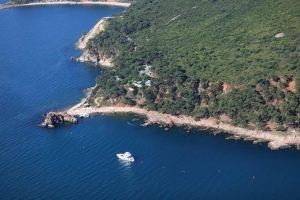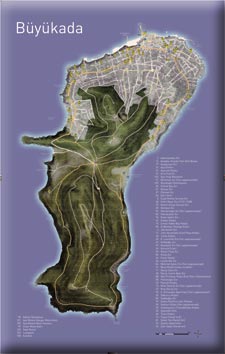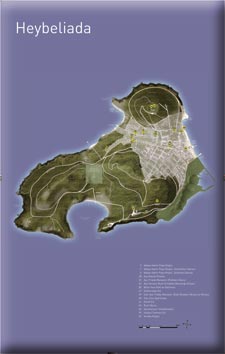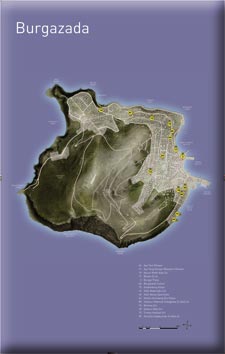Burgazada - Beyond the Center
- Details
- Created on 11 April 2013
- Last Updated on 11 April 2013
The Monastery of Hagios Georgios
 The Greek Orthodox monastery of Hagios Georgios (St. George) Karyptis is on the northern shore of the island, approached from Gönüllü Caddesi. The gateway leads to the grounds of the katholikon, from which a flight of steps leads down to the dormitory of the monastery, a two-storey stone building.
The Greek Orthodox monastery of Hagios Georgios (St. George) Karyptis is on the northern shore of the island, approached from Gönüllü Caddesi. The gateway leads to the grounds of the katholikon, from which a flight of steps leads down to the dormitory of the monastery, a two-storey stone building.
Although the monastery is believed to have been founded in the Byzantine era, the earliest reference to it is in the second half of the seventeenth century. This is when the Greek innkeepers of Istanbul decided to restore and maintain the monastery, which apparently had fallen into ruins.
The present church was built in 1897 on an endowment provided by Simeon Sinyosoğlu. It is built on the Greek-cross plan of medieval Byzantine architecture, probably repeating the design of the original katholikon. The church has a particularly fine iconostasis, carved out of wood and embossed with gold, and also an episcopal throne of finely-carved wood. On the reverse side of the icons are inscribed the words: "By thy servant Joachim, Monk from Crete, in the year of our Blessed Lord 1818." The iconostasis dates from the eighteenth century and is undoubtedly from the katholikon of the earlier monastery.
Hristos (Christ) Tepesi and the Byzantine Monastery of the Theokoryphotos
 The site of the Byzantine monastery of the Theokoryphotos, the Transfiguration of Christ, is on the summit of Hristos (Christ) Tepesi, as suggested by the name of the hill. Greek tradition, unverified by the Byzantine sources, has it that the monastery was founded by the emperor Basil I the Macedonian (r. 867-86) on the ruins of an ancient Greek temple. There is evidence of a chrysobull of the emperor Manuel I Comnenos granting the Theokoryphotos its rights as a monastery in 1158. The earliest reference to the monastery after the conquest is c. 1547 by the French scholar Petrus Gyllius, who reported that it was virtually intact.
The site of the Byzantine monastery of the Theokoryphotos, the Transfiguration of Christ, is on the summit of Hristos (Christ) Tepesi, as suggested by the name of the hill. Greek tradition, unverified by the Byzantine sources, has it that the monastery was founded by the emperor Basil I the Macedonian (r. 867-86) on the ruins of an ancient Greek temple. There is evidence of a chrysobull of the emperor Manuel I Comnenos granting the Theokoryphotos its rights as a monastery in 1158. The earliest reference to the monastery after the conquest is c. 1547 by the French scholar Petrus Gyllius, who reported that it was virtually intact.
But by the end of the eighteenth century the monastery was an abandoned ruin.
All that remains is a nineteenth-century church and a two-storey building erected in the eighteenth century, along with the ruins and architectural fragments of earlier structures scattered about the former enclosure of the monastery. Inside the entrance to the enclosure there are a number of ancient architectural fragments that include four beautifully carved Byzantine capitals.
Within the monastery precinct are four large vaulted underground cisterns which still collect rainwater even today
The view from the hilltop is superb, with all of the other islands of the archipelago in view as well as the Asian shore of the mainland opposite. Greeks and others still come to the church to mark the panigiri of the Transfiguration on August 6, which in times past would have been celebrated with music and dancing on the hilltop.
The Greek cemetery is just above the site of the monastery. The little church in the cemetery is dedicated to Hagios Profitis Ilias, the Prophet Elijah, whose chapels are always on hilltops.
Roman Catholic Monastery
There is also a Roman Catholic monastery dedicated to St. George in the southeastern part of the island. This was founded in 1938 by the Austrian School and Church of St. George in Galata as a summer school and residence.
Kalpazankaya
 A final stop on Burgazada might be the Kalpazankaya restaurant, on a point on the southwest side of the island—this will require a fayton ride. Long a favorite with island residents and visitors, this traditional summer restaurant, set on a hillside among pine trees, features rustic wooden tables in the open air and simple fare. It is equally pleasant for a leisured lunch or a moonlight supper.
A final stop on Burgazada might be the Kalpazankaya restaurant, on a point on the southwest side of the island—this will require a fayton ride. Long a favorite with island residents and visitors, this traditional summer restaurant, set on a hillside among pine trees, features rustic wooden tables in the open air and simple fare. It is equally pleasant for a leisured lunch or a moonlight supper.







